We’re challenged by the urgent need to reduce carbon emissions to fight climate change. In our article 7 Valuable Reasons EVs Reduce Your Carbon Footprint, we reviewed why automotive electrification is a crucial part of America’s sustainable transportation future given the potential to dramatically reduce carbon emissions, especially when connected to an electricity grid increasingly powered by renewable energy. In that guide we discussed how an Electric Car emits less C02 than its internal combustion engine counterpart during operation and it has zero tailpipe emissions. In fact, an average gas car emits 280 percent more carbon per mile than an electric vehicle. While there’s some truth that an EV comes with higher upfront emissions, these emissions are greatly offset over time by the reduction in gas required by these vehicles. Based on our research and experience, electric vehicles are part of our sustainable future since the carbon footprint of electric cars is much lower than gasoline-powered vehicles.
Meanwhile the car industry is undergoing a transformational shift towards the electrification of transportation. At the forefront of this automotive electrification energy transition is a new breed of electric vehicles, (EVs), which offer a clear upgrade to the traditional internal combustion engine, (ICE)cars. It’s increasingly clear that EV owners enjoy a magnitude of benefits, ranging from environmental friendliness and reduced operating cost to technological innovation and an enhanced driving experience. The environmental benefits to owning and driving an EV everyday are proven, but the dramatic cost savings and economic dividends EVs offer in comparison to ICE cars are still not clear to many consumers.
In this article we’ll share our experiences and present the economic benefits of owning an EVs versus an ICE car, we’ll present visual comparisons between electric vehicles and gas vehicles, and define the related steps you can take to adopt The Automotive Clean Energy Life and enjoy significant savings on your annual transportation costs.
Beyond their environmental merits, electric vehicles offer 5 undeniable economic benefits over internal combustion engine (ICE), vehicles.

High prices for certain EVs are a point of contention for some but you may be surprised to discover that EV prices are continuing to fall in 2023, (NYTimes: Electric Vehicles Could Match Gasoline Cars on Price This Year), and as we’ll demonstrate from our personal experiences in this article, the total cost of ownership can to be significantly lower than that of a traditional combustion vehicle due to:
EV Tax Credits, Rebates and Subsidies for EVs are a large factor in reducing the initial cost of purchasing an electric vehicle. The IRS Federal EV Tax Credit offers up to $7,500 to an individual who purchases a new electric vehicle depending on the following vehicle qualifications:
From IRS.Gov – Credits for New Clean Vehicles Purchased in 2023 or After | Internal Revenue Service
To qualify, a vehicle must:
The sale qualifies only if:
In addition, the vehicle’s manufacturer suggested retail price (MSRP) can’t exceed:
MSRP is the retail price of the automobile suggested by the manufacturer, including manufacturer installed options, accessories and trim but excluding destination fees. It isn’t necessarily the price you pay.
You can find your vehicle’s weight, battery capacity, final assembly location (listed as “final assembly point”) and VIN on the vehicle’s window sticker.
The Federal EV Tax Credit alone will mitigate a large portion of the price difference between an electric and an internal combustion vehicle. Many states offer their own incentives as well in the form of tax credits, rebates or reduced registration and insurance fees, for example the State of NJ has no sales tax on EVs. Some urban areas offer reductions on parking fees and congestion charges when operating an electric vehicle within their city limits. Immediately the purchase of an electric vehicle is made easier when you allow for the numerous rebates and tax credits that are available.
Vehicle maintenance is much less expensive for an EV than an ICE car. As a matter of fact, maintenance for an EV is almost nonexistent since EVs have about 1% of the moving parts of an ICE car and none of the fluids, filters, plugs, transmissions and exhaust systems. A combustion car requires routine oil changes to ensure the engine operates smoothly. You will also have to replace spark plugs and emissions related equipment. EVs lack all those components and therefore never require service for them. Other than an occasional $60 tire rotation, (Tesla performed the tire rotation service in my driveway), our electric cars require little or no maintenance saving us a significant amount of money. Based on our personal savings, we’ve spent next to nothing on service and maintenance over the years as compared to the hundreds to thousands of dollars spent owning an older or a premium ICE vehicle.
Also, Electric Vehicles have regenerative braking. You may believe that brake pads on an EV would require the same routine maintenance as on an EV, but this is not the case. Most electric vehicles use regenerative braking, this energy recovery process occurs when the drivers lift their foot off the accelerator or puts their foot on the brake using the braking power of the electrical motor. The electric motor operates in reverse using engine braking to decelerate the car and then generates a small amount of energy to charge the vehicle’s battery in return. As a result, the brakes on an electric vehicle last significantly longer than those on a traditional combustion car. In normal braking energy is lost to friction and heat. Regenerative braking not only increases the range of the car but significantly reduces wear on the brake pads and mechanical brake components, according to Clean Technica’s article Servicing An Electric Vehicle Vs. A Gas Vehicle, “due to regenerative braking, EVs use their brakes less frequently than ICE vehicles, resulting in less wear and tear on brakes and brake pads. Some estimates hold that they can even last twice as long on EVs.”
Electric Cars are more efficient than ICE cars.
In our article 7 REASONS TO BUY AN EV: YOUR GUIDE TO THE BEST ELECTRIC CARS, we discuss the points that EVs have 8 to 11 times lower monthly fuel costs, 280% less carbon emissions, and very low maintenance costs. Many of these benefits stem from the fact that electric motors are ~90% efficient compared to a typically ~30% efficient gasoline engine.
The reason that EVs are more efficient is because electric motors simply deliver nearly 100% of their power directly to the car’s drive shaft, on the other hand, gas-powered engines must convert chemical/thermal power to mechanical power. During this conversion, the combustion engine loses almost 70% of its energy.
These losses include radiant and conductive heat, energy lost to running various pumps, transmission, exhaust, and even noise and vibration, none of these losses occur in an electric engine. An electric engine is ~90% efficient compared to a ~30% efficient gas engine, meaning the EV not only has a lower carbon footprint but is 60% more economical and efficient to operate.
Annual savings are primarily a result of the lower cost of fueling your vehicle. Studies from the Federal Highway Administration indicated that the average American drives roughly 13,500 miles a year, (see United States Department of Transportation – Federal Highway Administration, Average Annual Miles per Driver by Age Group). This section gives consumers an idea of what they can save in that 13,500-mile span with an electric vehicle as opposed to a traditional car. The team at The Clean Energy Life used Levelized Cost of Energy (LCOE) to create a metric in which we can fairly compare the cost per mile of combustion cars to those of EVs. This calculation was the total cost of driving in a year (including fueling and maintenance) divided by the number of miles driven. We used the national average for miles driven in our calculation. Below will be a description of the savings and a graph to provide a visual depiction.*
Charging an electric vehicle at home or at a supercharger location does cost the driver, but it is considerably cheaper than fueling a car at a typical gas station. In their article How Electric Cars Compare to Gas-Powered Cars for Operating Costs iseecars.com uses a VW ID as their average electric car cost of $0.043 per mile or roughly four cents. With the average of 13,500 miles driven per year, this makes a total operating cost of ~$540 a year. As the chart below will show you, the cost per mile for combustion cars are quite a lot higher. The luxury options range from $0.14 to $0.16 per mile, and the more typical mid-sized sedans range from $0.10 to $0.11 per mile. This means annual operating costs for a combustion car can range anywhere from $1,250 to $2,000. The initial difference in cost of purchasing an electric vehicle is mitigated within a few years of ownership due to the much cheaper operation costs. The annual costs of owning an electric vehicle are significantly lower than those of a combustion car, but there are more cost savings steps one can take.
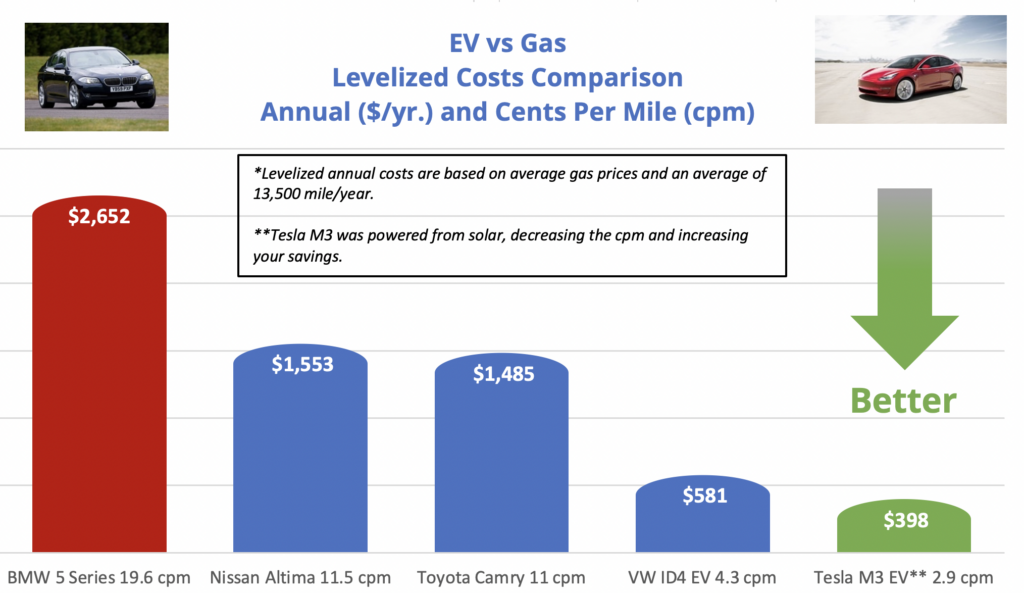
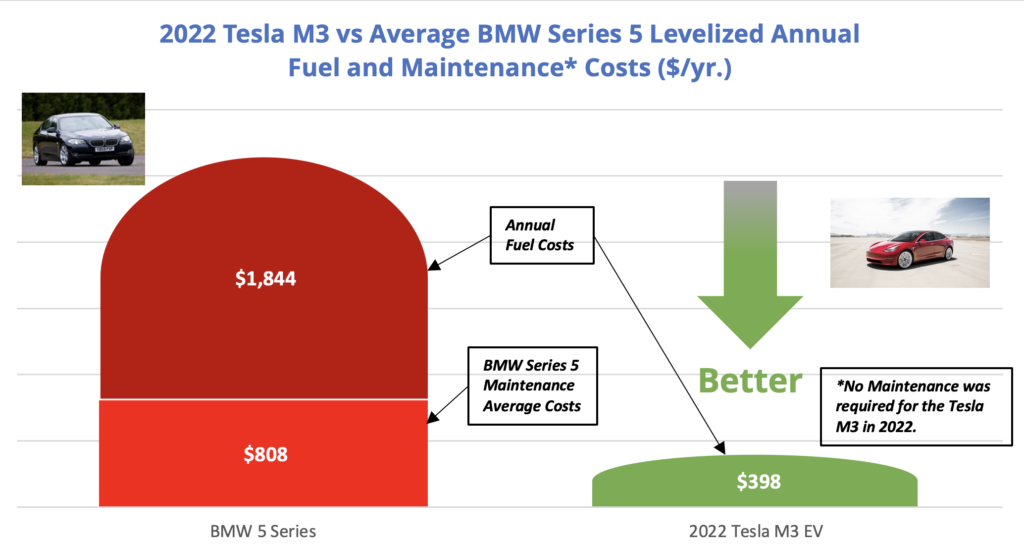
Home solar panels can drive your cost even lower, thereby accelerating the benefits of using an EV. Electrifying your personal transportation is a bold step towards adopting The Clean Energy Life, but powering your home with Solar Energy can further double the economic benefits of your EV . The Tesla Model 3, an increasingly popular electric vehicle, has similar specs to the average electric car that was mentioned previously in this article. The specific model that we used for our study has been charged for its lifetime in a home with solar power. Generating your own power with solar and not relying on the grid, is another step one can take towards The Clean Energy Life and even more significant cost savings. In our expert’s experience our specific Tesla, that used solar power to charge daily, had a cost of just over 2 cents/mile. With the nationwide average of 12,500 miles driven this equates to an annual cost of only $250! While the logistics and costs of installing solar power in one’s home are not simple, this is an indication of the benefits that are possible if the extra steps are taken. Realistically, the only necessary maintenance for an EV is a routine tire rotation. Bill Canis, a vehicle-industry analyst, noted in a recent Forbes Magazine article that conventional gas engine powertrains may have as many as 2,000 moving parts, while electric powertrains may have as few as 20. Regenerative braking, and the lack of mechanical components, means maintenance costs fall to next to nothing. Our in-house example with the Tesla Model 3 in conjunction with solar power shows the true environmental and economic potential of making this important switch.
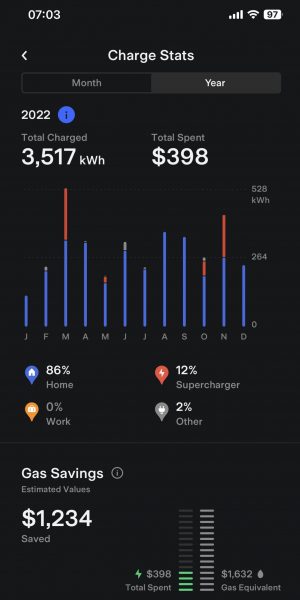
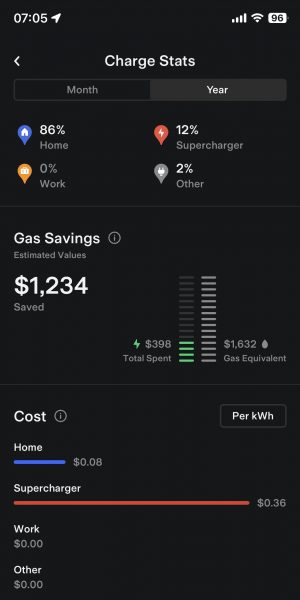
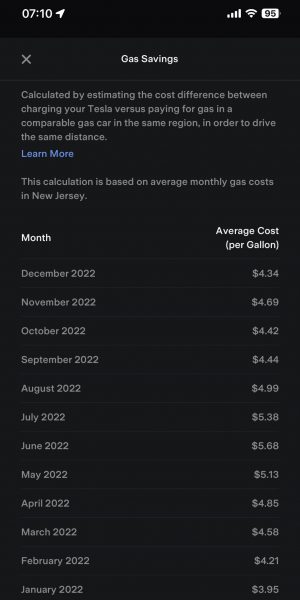
As the automotive industry quickly moves towards a future defined by sustainability, the choice between an electric and combustion vehicle is becoming increasingly significant. The advantages of electric vehicles extend far beyond their eco-friendly nature. Once you understand the economic benefits, the initial purchase price becomes less intimidating. Here are the Key Takeaways:

There are many steps you can take towards a clean energy life. In our experience owning an electric vehicle is a great place to start because it will save you a considerable amount each year and support your upgrade to a cleaner lifestyle. With new technologies, improved driving experience, significant cost savings, sustainability and continuous innovation, the time is for you to reconsider the typical idea of what a motor vehicle is. The Clean Life Team looks forward to helping our community achieve the exciting benefits of Automotive Electrification.
Please note: This page contains affiliate links, if you choose to purchase after clicking a link, The Clean Energy Life may receive a commission at no extra cost to you. We only link to products we know and use ourselves.
Driving the clean energy movement one step at a time and making a positive impact on the environment.
The Clean Energy Life is part of the Rewire Group and is a companion site to Rewire Energy, and Rewire Digital.
Website Copyright 2023, Rewire Group LLC, DBA – The Clean Energy Life, All rights reserved.
Website Hosting and design by Rampant Imaginations